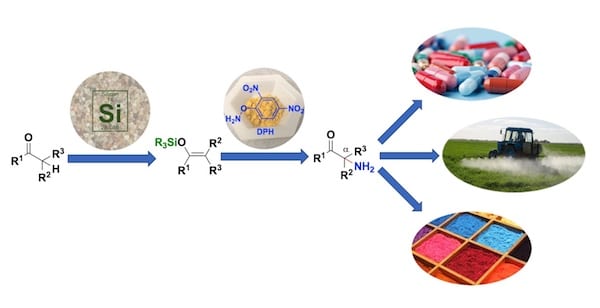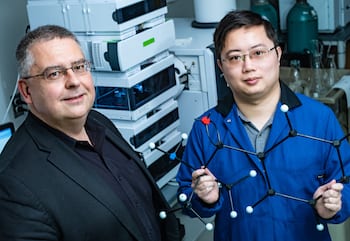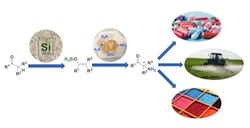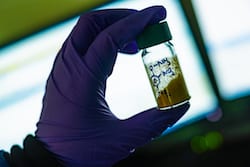NEWS RELEASE
Editor’s note: Links to high-resolution images for download appear at the end of this release.
Jeff Falk
713-348-6775
jfalk@rice.edu
Mike Williams
713-348-6728
mikewilliams@rice.edu
Nitrogen gets in the fast lane for chemical synthesis
‘Great gift to industry’: Rice U. chemists discover way to simplify synthesis of valuable precursor for drugs, other compounds
HOUSTON – (Feb. 8, 2019) – Rice University scientists have given organic chemists a boost with their latest discovery of a one-step method to add nitrogen to compounds for drugs, pesticides, fertilizers and other products.
Rice synthetic organic chemist László Kürti said the method, reported in the Journal of the American Chemical Society, is a major step forward as it quickens and boosts the yield of valuable molecules known as alpha-aminoketones.

Rice University chemists have discovered a one-step method to turn silicon-based silyl enol ether into nitrogen-bearing alpha-aminoketones, valuable building blocks in chemical design. Illustration by Zhe Zhou
Ketones are carbon-based compounds found in nature and important feedstocks for the chemical industry. The primary amino group (NH2) is a functional group present in many important chemical products. It contains one nitrogen atom and two hydrogen atoms. When a ketone is functionalized with a primary amino group at the alpha carbon, it forms a compound called a primary alpha-aminoketone.
“It’s a good precursor, because there’s no extra functionalization, like an acyl group, on the NH2 and it can then be converted to whatever you want,” said Kürti, an associate professor of chemistry. “Previously, this was the issue: People would put nitrogen in there with extra functionality, but the further processing necessary to get to a free NH2 was complicated.”

Rice postdoctoral researcher Zhe Zhou is lead author of a paper on the discovery of a one-step method to make nitrogen-bearing alpha-aminoketones, valuable building blocks in chemical design. Photo by Jeff Fitlow
Postdoctoral researcher Zhe Zhou discovered the reaction when he mixed a silyl enol ether and a nitrogen source in a common solvent, hexafluoroisopropanol, at room temperature and found that it mimicked Rubottom oxidation, an established technique to oxidize enol ethers.
“Oxygen is routinely put into the alpha position,” Kürti said. “But nitrogen, no. We are the first to show this is possible in a large number of substrates, and it’s simple. It turns out that the solvent itself catalyzes the reaction.”
Zhou and co-author and postdoctoral researcher Qing-Qing Cheng refined the method and subsequently tested it by making 19 aminoketones, including three synthetic amino acidprecursors. “These unnatural amino acids are significant for drug design,” Kürti said. “The enzymatic processes in living organisms are not going to attack them, because they don’t fit in the enzymes’ pockets.”
“Before we had this process, it wasn’t impossible to make these kinds of structures,” Zhou said. “It was just very complicated and took many steps. The goal, generally, is to get them by the most direct method possible.”
Earlier synthetic processes by the Kürti lab eliminated the need for transition metal-based catalysts in the manufacture of amines in order to simplify the usual and often inefficient trial-and-error approach involved in making new chemical compounds like drugs. Metal-based catalysts that speed up amination — the introduction of amine groups to an organic molecule — can also contaminate the product, so the new process avoids them as well.
“Our amination method promises to replace a common three-step process to make alpha-aminoketones, and the yield, comparably, is very good,” Zhou said. “In the standard process, each step cuts the yield, so one-step process is still superior even if the yields are identical, because it takes less time and there’s less risk of something going wrong.
“The last thing you want is to get eight steps from the beginning and then ruin it on the ninth because the conditions are not selective enough,” he said. “Cutting steps is always beneficial in organic synthesis.”
Kürti was delighted to see his social media accounts light up with congratulations from peers and industrial acquaintances upon publication of the paper.
“There’s a new trend toward late-stage functionalization, where companies with an existing library of compounds can take 100 of them and perform an additional step to make 100 new compounds,” he said. “So from an intellectual property perspective, our discovery is a great gift to industry. This really is a gem of a find.”
The National Institutes of Health, the National Science Foundation, the Robert A. Welch Foundation and Rice University supported the research.
-30-
Read the abstract at https://pubs.acs.org/doi/10.1021/jacs.8b13818.
Follow Rice News and Media Relations via Twitter @RiceUNews.
Related materials:
Chemists make strides to simplify drug design and synthesis: http://news.rice.edu/2016/09/12/chemists-make-strides-to-simplify-drug-design-and-synthesis/
Rice scientists simplify the incorporation of nitrogen into molecules: http://news.rice.edu/2017/07/12/rice-scientists-simplify-the-incorporation-of-nitrogen-into-molecules-2/
Greener molecular intermediates may aid drug design: http://news.rice.edu/2017/07/05/greener-molecular-intermediates-may-aid-drug-design-2/
Kürti Research Group: http://kurtilabs.com
Rice Department of Chemistry: https://chemistry.rice.edu
Wiess School of Natural Sciences: https://naturalsciences.rice.edu
Images for download:
https://news2.rice.edu/files/2019/02/0211_KETONES-1-web-26cexaq.jpeg
Rice University chemists have discovered a one-step method to turn silicon-based silyl enol etherinto nitrogen-bearing alpha-aminoketones, valuable building blocks in chemical design. (Credit: Illustration by Zhe Zhou/Rice University)
https://news2.rice.edu/files/2019/02/0211_KETONES-2-web-2c5xbms.jpg
Rice University postdoctoral researcher Zhe Zhou is lead author of a paper on the discovery of a one-step method to turn silicon-based silyl enol etherinto nitrogen-bearing alpha-aminoketones, valuable building blocks in chemical design. (Credit: Jeff Fitlow/Rice University)
https://news2.rice.edu/files/2019/02/0211_KETONES-3-web-28ffjza.jpg
A one-step method by synthetic organic chemists at Rice University allows nitrogen atoms to be added to precursor compounds used in the design and manufacture of drugs, pesticides, fertilizers and other products. (Credit: Jeff Fitlow/Rice University)
https://news2.rice.edu/files/2019/02/0211_KETONES-4-web-1yjlx9d.jpg
Rice University researchers László Kürti, left, and Zhe Zhou led an effort to develop a one-step method that allows nitrogen atoms to be added to precursor compounds used in the design and manufacture of drugs, pesticides, fertilizers and other products. (Credit: Jeff Fitlow/Rice University)
Located on a 300-acre forested campus in Houston, Rice University is consistently ranked among the nation’s top 20 universities by U.S. News & World Report. Rice has highly respected schools of Architecture, Business, Continuing Studies, Engineering, Humanities, Music, Natural Sciences and Social Sciences and is home to the Baker Institute for Public Policy. With 3,962 undergraduates and 3,027 graduate students, Rice’s undergraduate student-to-faculty ratio is just under 6-to-1. Its residential college system builds close-knit communities and lifelong friendships, just one reason why Rice is ranked No. 1 for lots of race/class interaction and No. 2 for quality of life by the Princeton Review. Rice is also rated as a best value among private universities by Kiplinger’s Personal Finance. To read “What they’re saying about Rice,” go to http://tinyurl.com/RiceUniversityoverview.






